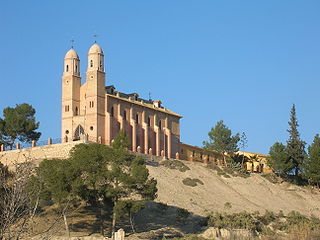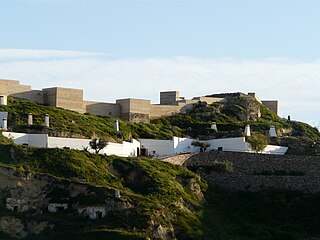
Murcia is a city in south-eastern Spain,the capital and most populous city of the autonomous community of the Region of Murcia,and the seventh largest city in the country. It had a population of 460,349 inhabitants in 2021. The total population of the metropolitan area was 672,773 in 2020,covering an urban area of 1,230.9 km2. It is located on the Segura River,in the southeast of the Iberian Peninsula. It has a climate with hot summers,mild winters,and relatively low precipitation.

Real Murcia Club de Fútbol,S.A.D.,commonly known as Real Murcia,is a Spanish football club based in Murcia,in the Región de Murcia. Founded in 1919,it currently plays in Primera Federación –Group 2,playing home matches at Estadio Nueva Condomina,which holds 31,179 spectators.

Cieza is a town and municipality in Spain,in the autonomous community of Murcia. It is the capital of the Vega Alta comarca,an old form of provincial subdivision). Its current population consisted of 34,889 inhabitants in the year 2018. The Segura River passes by the town.

Abanilla is a Spanish municipality located in the Comarca Oriental in the Autonomous Community of Murcia. It lies close to the border of the province of Alicante in the Autonomous Community of Valencia.

Puerto Lumbreras is a Spanish municipality in the autonomous community of Murcia. It has a population of 15,780 (2020) and an area of 139 km2. It is located in the southwestern end of Region of Murcia and is adjacent to Andalusia.

The Region of Murcia is an autonomous community of Spain located in the southeastern part of the Iberian Peninsula,on the Mediterranean coast. The region is 11,313 km2 (4,368 sq mi) in area and had a population of 1,511,251 as at the start of 2020. About a third of its population lives in the capital,Murcia,and a seventh in the second city,Cartagena. At 2,014 m (6,608 ft),the region's highest point is Los Obispos Peak in the Massif of Revolcadores.

The President of the Region of Murcia,is the head of government of the Spanish autonomous community of the Region of Murcia. Since 2014,no person who has been elected to two terms may be elected to a third.

The 1983 Murcian regional election was held on Sunday,8 May 1983,to elect the 1st Regional Assembly of the autonomous community of the Region of Murcia. All 43 seats in the Regional Assembly were up for election. The election was held simultaneously with regional elections in twelve other autonomous communities and local elections all throughout Spain.

The 1987 Murcian regional election was held on Wednesday,10 June 1987,to elect the 2nd Regional Assembly of the autonomous community of the Region of Murcia. All 45 seats in the Regional Assembly were up for election. The election was held simultaneously with regional elections in twelve other autonomous communities and local elections all throughout Spain,as well as the 1987 European Parliament election.

The 1991 Murcian regional election was held on Sunday,26 May 1991,to elect the 3rd Regional Assembly of the autonomous community of the Region of Murcia. All 45 seats in the Regional Assembly were up for election. The election was held simultaneously with regional elections in twelve other autonomous communities and local elections all throughout Spain.

The 1995 Murcian regional election was held on Sunday,28 May 1995,to elect the 4th Regional Assembly of the autonomous community of the Region of Murcia. All 45 seats in the Regional Assembly were up for election. The election was held simultaneously with regional elections in twelve other autonomous communities and local elections all throughout Spain.

District One was one of the five constituencies represented in the Regional Assembly of Murcia,the regional legislature of the Region of Murcia. The constituency elected seven deputies. It comprised the municipalities of Lorca,Aguilas,Puerto Lumbreras,Totana,Alhama de Murcia,Librilla,Aledo and Mazarrón. The electoral system used the D'Hondt method and a closed-list proportional representation,with a minimum threshold of five percent regionally.

District Two was one of the five constituencies represented in the Regional Assembly of Murcia,the regional legislature of the Region of Murcia. The constituency last elected 11 deputies in 2015. It comprised the municipalities of Cartagena,La Unión,Fuente Alamo de Murcia,Torre-Pacheco,San Javier,San Pedro del Pinatar and Los Alcázares. The electoral system used the D'Hondt method and a closed-list proportional representation,with a minimum threshold of five percent regionally.

District Three was one of the five constituencies represented in the Regional Assembly of Murcia,the regional legislature of the Region of Murcia. The constituency last elected 21 deputies in 2015. It comprised the municipalities of Murcia,Alcantarilla,Beniel,Molina de Segura,Alguazas,Las Torres de Cotillas,Lorquí,Ceutí,Cieza,Abarán,Blanca,Archena,Ricote,Ulea,Villanueva del Río Segura,Ojós,Fortuna,Abanilla and Santomera. The electoral system used the D'Hondt method and a closed-list proportional representation,with a minimum threshold of five percent regionally.

District Four was one of the five constituencies represented in the Regional Assembly of Murcia,the regional legislature of the Region of Murcia. The constituency last elected four deputies in 2015. It comprised the municipalities of Caravaca,Cehegín,Calasparra,Moratalla,Bullas,Pliego,Mula,Albudeite and Campos del Río. The electoral system used the D'Hondt method and a closed-list proportional representation,with a minimum threshold of five percent regionally.

District Five was one of the five constituencies represented in the Regional Assembly of Murcia,the regional legislature of the Region of Murcia. The constituency last elected two deputies in 2015. It comprised the municipalities of Yecla and Jumilla. The electoral system used the D'Hondt method and a closed-list proportional representation,with a minimum threshold of five percent regionally.

The 2023 Murcian regional election was held on Sunday,28 May 2023,to elect the 11th Regional Assembly of the autonomous community of the Region of Murcia. All 45 seats in the Regional Assembly were up for election. The election was held simultaneously with regional elections in eleven other autonomous communities and local elections all throughout Spain.
The Council of Government of the Region of Murcia is the collegiate body charged with the executive and administrative functions of the autonomous community of the Region of Murcia,Spain.

In Spain,a president of an Autonomous Community serves as the chief executive officer in each of the seventeen Autonomous communities and in the two Autonomous cities,where they receive the name of "Mayor-Presidents". As such,regional presidents are responsible for implementing regional laws and overseeing the operation of the state executive branch. As regional leaders,governors advance and pursue new and revised policies and programs using a variety of tools,among them executive laws,executive budgets,and legislative proposals.

















